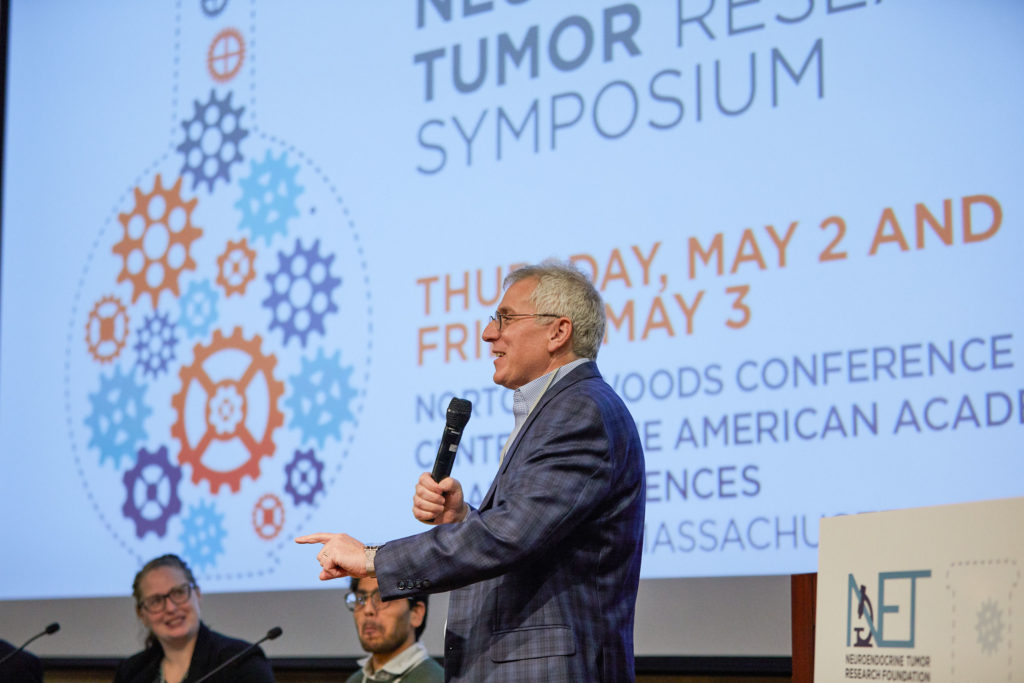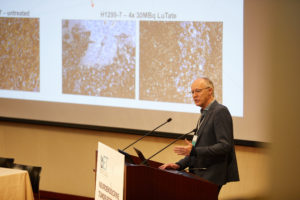Latest in NET Cancer Research
Neuroendocrine Tumor Research Foundation (NETRF) held its 11th Annual Research Symposium on May 2-3, 2019, in Cambridge, MA. More than 100 neuroendocrine tumor researchers and clinicians from 25 states and eight countries came together for two days to share progress and plans to advance the knowledge and treatment of NETs.
Physicians and scientists who have been involved with NETRF for more than a decade spoke inspirationally about NETRF’s progress in NETs, indicating that some of the early objectives of those who started the Foundation in 2005 were coming to fruition.

Early NETRF-funded researcher Matthew Meyerson, MD, said it was rewarding to be part of the evolution of NET research. “Remarkable progress has been made in the last ten-plus years. It is truly extraordinary. It has gone from a question of whether it can be done to seeing it and being amazed at how well it can be done.”
NETRF’s Board of Scientific Advisors, Evan Vosburgh, MD, said we are at a tipping point, moving from follower to leader, “When you look at the quality of the work being presented, I think we will now be informing other tumor types. It’s almost flipped.”
Presenters at the conference shared unpublished research in many areas. Presentations on laboratory models, immuno-oncology, and nuclear medicine sparked the most discussion.
Building laboratory models of NETs
A lack of laboratory models has impeded progress in NETs for decades. NETRF has invested heavily in models since its inception.
“I think we have a lot of reasons to feel quite optimistic that there are positive developments coming through,” said Dan Chung, MD, Co-Chair, NETRF Board of Scientific Advisors.
Presenters shared promising results in organoids, 2-D cell lines, and patient-derived xenograft models.
Dr. Meyerson applauded the progress in creating cellular models to understand how and why NETs develop and to test new treatments. “It is going to make a huge difference in in terms of doing mechanistic and pharmacological studies.”
Next generation nuclear medicine
 Four active NETRF grantees presented progress in making peptide receptor radionuclide therapy (PRRT) more effective for more people, with reduced side effects. Discussion surrounded the promising role of alpha particle radiopharmaceuticals in increasing the precision of PRRT to minimize damage to healthy tissue, for example, in the lungs, and to help to eliminate the smallest traces of NET cells to prevent metastasis.
Four active NETRF grantees presented progress in making peptide receptor radionuclide therapy (PRRT) more effective for more people, with reduced side effects. Discussion surrounded the promising role of alpha particle radiopharmaceuticals in increasing the precision of PRRT to minimize damage to healthy tissue, for example, in the lungs, and to help to eliminate the smallest traces of NET cells to prevent metastasis.
NETRF Board of Scientific Advisors Co-Chair George Fisher, MD, said he saw great potential in alpha therapy. “I think that that technology someday could represent, when combined with surgery to remove cancer, a potential cure, which is not a word that rolls off our tongue as often as we’d like. So, I’m proud that NETRF is investing in that research.”
The nuclear medicine session included a presentation from Profession Richard Baum, MD, PhD, Zentralklinik Bad Berka, Germany, a world renowned expert in PRRT. Baum spoke of a future of precision oncology, where nuclear medicine is tailored to an individual’s molecular profile [based on molecular imaging] and not bound by a specific dosing regimen. “You can look at the patient’s molecular features before you start the treatment. Therefore, we can select the right patients, for the right treatment, with the right radio isotope.”
Clinical research of new treatments
New grantees presented plans for innovative pilot projects that will explore a vaccine and smart chemotherapy. Ramesh Shivdasani, MD, PhD, member NETRF Board of Scientific Advisors, pointed out that explorations of uncharted territory like this are considered too risky to be funded by other entities. “Many of the projects we remarked on for their progress would be impossible to achieve under conventional NIH/RO1 funding mechanisms. The Foundation is to be congratulated for taking a lot of risks.”
University of California, San Francisco researcher Chester Chamberlin, PhD, presented an update on NETRF-funded research that he said was a “gamble” when proposed, but in the end contributed enormously to the field. “We really started with very little or nothing. If you tried to go to the NIH, for example, with an ‘idea,’ you’ll get turned away. They like to see a lot of very preliminary evidence that what you’re proposing to do is going to work. But NETRF had that faith in us we were able to do it.”
Chamberlin and colleagues succeeded in creating a patient-derived xenograft model. While testing drugs on the new model, they identified a new treatment in everolimus-resistant pancreatic NETs, sapanisertib. Sapanisertib is in phase II clinical trials in 406 locations, supported by NIH funding.
“We are proud that we have supported researchers to explore new approaches to understand NETs and their work is showing early results,” says Elyse Gellerman, NETRF chief executive officer. “NETRF’s ultimate goal is a future where every NET patient has effective treatment options.”
The next NETRF Research Symposium is planned for May 19-20, 2020 in Boston, MA. Email researchsymposium@netrf.org for more information.
